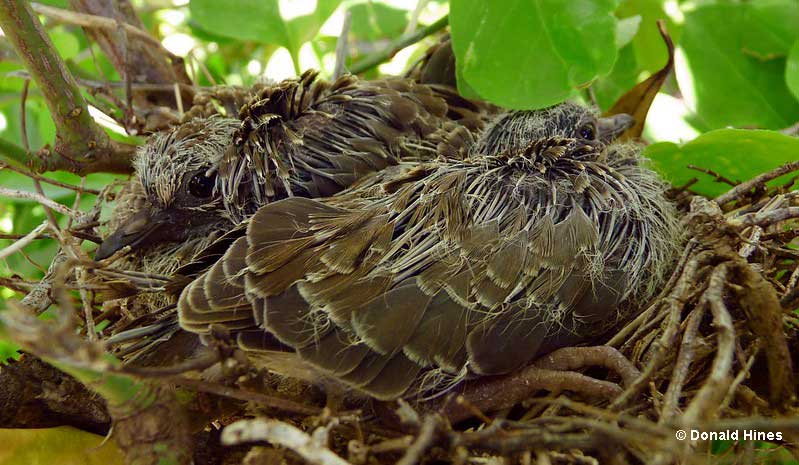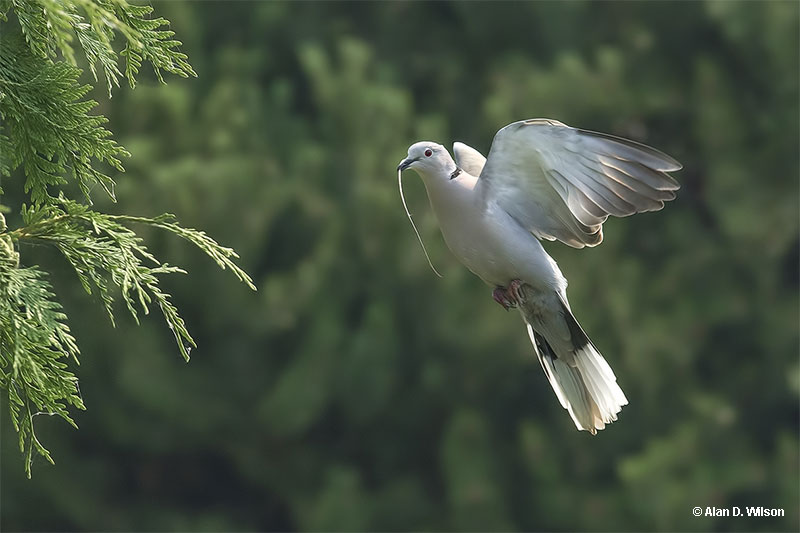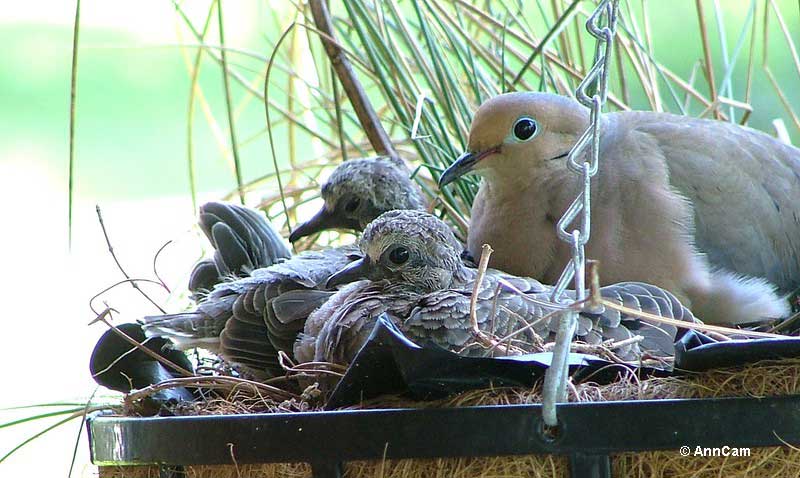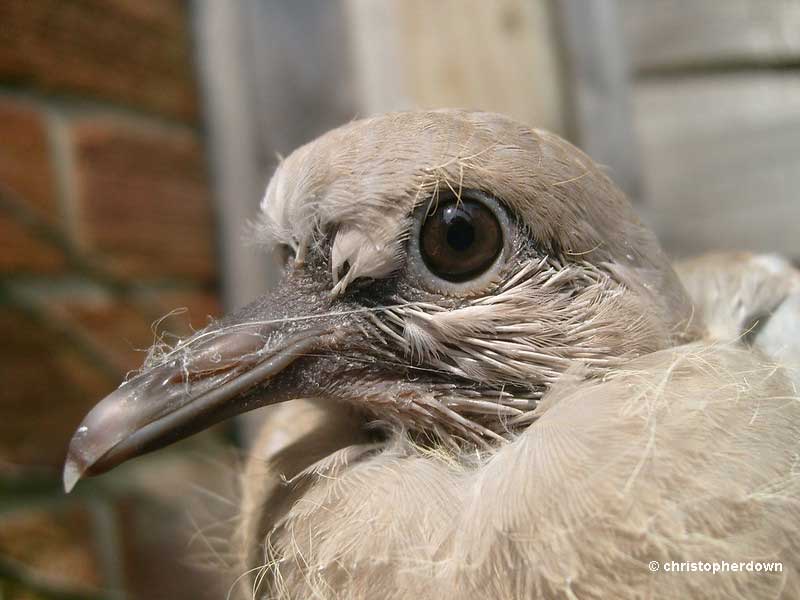
Baby doves are called squabs and chicks. While doves are a pretty common sight, baby doves are often hidden away, so it’s not common to see them.
Dove nests are almost always highly camouflaged, and when baby doves are born, they stay in the nest until they’re at least half the size of an adult.
Let’s go over everything you need to know about baby doves.
On this page
Nest
Doves build their nests on branches amongst dense foliage of orchard, evergreen, mesquite, and cottonwood trees or vines. Additionally, in the west, doves commonly nest on the ground. These birds have no issue with nesting around humans, so it’s not uncommon to see nests on abandoned equipment, eaves, and gutters as well.
Related: Do doves mate for life?
Dove nests are flimsy since they’re assembled with twigs, pine needles, and grass stems. They’re unlined and have a small amount of insulation for the squabs.

Eurasian Collared Dove building a nest © Alan D. Wilson
Over the span of 2 – 4 days, male doves carry twigs to the female and will pass them to her while standing on her back. Female doves take the twigs and weave them together to make a nest that’s about 8 inches wide. Lastly, doves are known to reuse their own or other bird species’ nests.
Baby doves fledge about 14 days after they hatch. However, they’ll stay close to their parents for about a month.
After 2 weeks, female doves will start preparing for their next brood while the male doves continue caring for the chicks.
After about 1 month, the squabs will fly off to join a flock of juveniles. At this time, the parents will begin incubating another brood. This breeding system is part of the reason why doves are such successful birds.
Doves usually have 1 to 6 broods per breeding season. There are usually two eggs in the clutch.
What Does A Baby Dove Look Like?
At birth, baby doves are completely covered in yellow-brown down feathers. They can look prehistoric with the combination of their down feathers and very dark skin.
Related: Baby Birds – From Hatching to Adulthood
Their beaks have a noticeable egg tooth and are dark in color. The egg tooth is a sharp, temporary projection on the beak that allows the hatchling to pierce the eggshell from the inside and break free.
Baby doves are unable to thermoregulate and weak after they first hatch. This means they need their parents to keep them warm for several days. Additionally, they’re unable to open their eyes or pick their heads up for about a week. However, despite being helpless when first born, they grow very quickly.
When squabs first hatch, they’re only a few centimeters long and weigh 5 grams (0.17 ounces). However, by the 7th day, the chicks will be about 10 centimeters long.
By the 10th day, the chicks measure about 15 centimeters long and weigh anywhere from 45 to 60 grams. This is nearly half the size of an adult!
How To Tell Baby Doves Apart?
At around the 10 to 14-day mark, baby doves are ready to fledge. Additionally, the squabs will have developed most, if not all, of their adult feather sheaths.
They’ll be almost entirely covered in their juvenile plumage. Juvenile dove plumage is brown and darker than adult plumage. They have a more speckled pattern which is theorized to provide camouflage.
At this time, baby doves will start rummaging around the area near the nest and exercising their wings. Even though these birds fledge earlier in their lives, they’ll spend around a month after fledging with their parents.
What Do Baby Doves Eat?
Like species of pigeons, baby doves eat crop milk for the initial 5 days after hatching. Crop milk and mammalian milk are sort of similar. However, crop milk is secreted from the crop of a bird, which is an extension of the digestive system.
Related: What do baby birds eat?
Both females and males make crop milk, and they’ll sometimes start producing crop milk as early as 2 to 3 days before the chicks even hatch!
After about 5 days of feeding squabs crop milk, the parents will start to introduce harder foods and seeds. At this point, the foods are partially digested and regurgitated into the chick’s mouth. However, not all birds produce crop milk. Those that do tend only feed it to their young in the first several days after they hatch.
Crop milk is very rich in fats and proteins; it helps babies put on large amounts of weight in a short period of time.
Parents will continue to feed their young for about a month. Most foods given to the chicks are regurgitated for the first week or so. After that, baby doves about 14 days old are fed the same foods that their parents eat, primarily berries, seeds, and grains.
Frequently Asked Questions
What does a fledgling dove look like?
Fledgling doves develop the majority, if not all, of their adult feather sheaths. Their plumage is brown and darker than adult plumage. In addition, they have a more specked pattern that provides camouflage.
What do you do if you find a baby dove?
If you find a baby dove, you first should see if you can locate the nest from which it fell. If you can’t find the nest, leaving the baby dove where you found it is best. However, if the dove is positioned in the sun, you should move it to a shaded location close to where you initially found it. Don’t worry about getting your scent on it; it won’t deter the parents!
How long do baby doves stay on the ground?
Fledgling doves can be seen on the ground for about 3 to 4 days before they can fly.
How can you tell if a dove nest is abandoned?
You can tell if a dove nest is abandoned by observing it for some time. If you do not see any progress in the nest, no hatched eggs or adults near the nest after four weeks, the nest may have been abandoned.
How long until a baby dove can fly?
Baby doves can fly around 14 days after they hatch. After that, however, they’ll stay close to their parents for about a month.
What does a baby dove eat?
Baby doves are given crop milk for the initial 5 days of their lives. After those 5 days, the parents will start to introduce harder foods and seeds. The foods given are partially digested and regurgitated into the chick’s mouth. Baby doves that are about 14 days old are fed the same foods that their parents eat, primarily berries, seeds, and grains. Parents will continue to feed their young for about a month.
Read next: What to do if you find a baby bird



